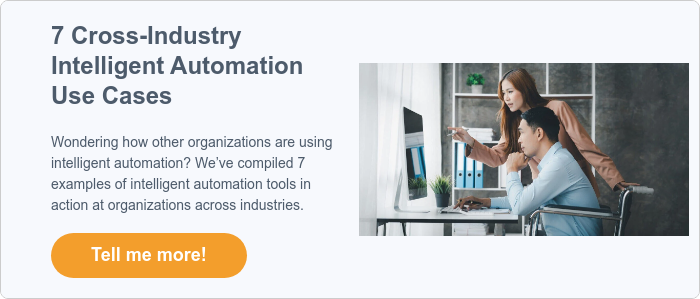The business world is in constant motion, and staying agile is a tall order for businesses big and small. But it’s especially tough if inefficient, convoluted processes are holding you back.
Even if it seems obvious that a process is broken, it can be difficult to pinpoint the exact points where the problem occurs. Bottlenecks can be complex or even invisible to the human eye. Fortunately, this limitation is becoming obsolete thanks to process mining.
Process mining helps you identify patterns to close even the most stubborn process gaps slowing down your business. It achieves this by giving you direct valuable insights into your processes, uncovering bottlenecks, and suggesting optimization opportunities. These capabilities make process improvement simpler and more effective, all without draining your resources or spending lavishly.
To help you start enjoying smoother processes sooner, let’s cut to the chase: Here are 6 steps to successful process mining. (Plus, read to the end to find a checklist for getting started.)
6 Process Mining Steps to Achieve Project Success
1. Choose Your First Process to Improve
Off the top of your head, you can probably name at least a few processes that desperately need work in your business. But to maximize your resources, it’s best to cut your teeth on “the ideal candidates.” That means looking for smaller-scale processes that:
Traits of a Process Primed for Process Mining
- You’re highly familiar with
- Occur at a high volume
- Are clearly defined and structured
- Have quality data that you can easily access (and if it includes timestamps, that’s even better.)
The “Infamous Process”
However, it’s also helpful to lead with a process with a strong sense of urgency behind it. You might even call it an infamous process: the kind of process that employees dread dealing with. When the people involved agree that there’s something wrong from the start, getting their buy-in and collaboration will be far easier.
But even if the process’ reputation isn’t quite infamous, you need to inform your relevant staff that changes are coming and why. This is where change management comes into play. If you nail it, you’ll thank yourself later when your employees gladly adapt their daily routines to embrace the changes (but more on that in step #6.)
2. Identify Your Project Team & Data Resources
When you’ve determined the subject of your first project, it’s time to assemble a project team. Key roles you’ll need to fill include:
Key Process Mining Roles
- The executive sponsor, who will be the project’s champion, is in charge of gaining executive buy-in, getting budget funds approved, managing sponsors, and setting strategic goals.
- The process owner is someone who’s close to the process in question and understands its pain points. They will define KPIs and project objectives, too.
- The business analyst will guide the process owner and users with process analysis. They will also lead the way in the scoping and analysis phases.
- The data expert will establish connections with source data and data preparation. They will also set up and load the data model, schedule regular data loads, and monitor the data pipeline.
- The project manager will coordinate all project-related tasks, so they will need to be able to scope it, set achievable milestones, and manage progress.
- IT experts may also be needed for implementation, especially if your project requires specific work for data integration or other issues. If your IT staff won’t be in charge of process improvement implementation, establish who will be taking this role.
With all these employees’ expertise combined, you can increase your chances of keeping your project on track and maximizing your results.
Additionally, you will need to determine your data sources. That means the application where the process’ data is stored. You’ll also need to establish how this data will be fed into your process mining tool.
3. Define What You Need to Measure and Why
Although you’ll already be well acquainted with the process in question, now’s the time to get to know it even deeper. That means looking at the main steps of the process and taking note of obvious pain points, how many instances the process handles annually, the typical end-to-end cycle time, and whether the process has experienced any material changes over the past year. You should also examine how many full-time employees it takes to facilitate the process currently and list any non-operational expenses associated with it.
All this context will help you define the KPIs you want to investigate for both business and operational outcomes. Then, you’ll be ready to establish specific goals for the process mining analysis. Your aims could include:
Process Mining Goal Criteria
- Evaluating how well your process aligns with KPIs.
- Pinpointing where in a process a problem begins occurring, like delays, missed deadlines, and underutilized resources.
- Understanding why your users are struggling to keep up with their workloads.
- Assessing whether specific process changes could lead to improvements in KPIs.
It’s best to narrow your goals down to the top three you want to prioritize to maximize your results. You’ll also want to establish a target process model or your vision of how your process will work when it’s fully optimized. This way, you’ll have a clear idea of where you’re aiming to go.
4. Collect and Process Your Data
Next, it’s data preparation time. You will need to extract your data from wherever it’s currently stored, whether that’s your ERP or another application. Your process mining tool will need all relevant event logs data to process and analyze your process.
Data Processing
Once you’ve run this data through your process mining tool, the technology will start mapping out a chronological sequence that visualizes all relevant tasks, transactions, and activities that occur during the end-to-end process. And it does so without operating under any assumptions or biases to form a truly accurate and reliable process depiction.
5. Analyze Your Process
Now that your end-to-end process visualization is ready, you can conduct your data analysis.
In your data exploration, be sure to look out for:
Data Analysis Considerations
- Evidence of resource overutilization or underutilization. Ideally, you don’t want to over or under-rely on any resource, be it an employee or a machine. Either way, there’s a good chance that resource or workload redistribution or even automation could help.
- Instances where no work is taking place. This is likely where your progress is getting stuck and time is being wasted.
- Skipped steps, which can lead to security and compliance problems.
- Occurrences that deviate from your target process model from step #3.
- Duplicate or redundant steps or loops that don’t contribute to your desired outcomes.
- Unexpected activities. This could occur due to a lack of sufficient planning, poor communication, or it could be a completely unnecessary action.
- Tasks that are repetitive, high volume, and manual. You’ll want to flag these as potential automation candidates.
- Extended waiting times between activities and process cycle times. This may lead you to the sources of process delays.
- Excessive variability. Some variability is natural, but too much can indicate inconsistent or unpredictable processes.
- Identify patterns of bottlenecks, escalations, or other slowdowns.
Dig Deeper into Your Data Exploration
In your data analysis, you can dig even deeper by limiting the display to specific time periods, products, industries, and steps. And that’s just the start: You’ll learn the ins and outs of your tool’s unique functionalities like this from your digital transformation partner. Once you’ve taken note of problem areas, you can dig deeper to find their root causes.
Another key part of the analysis stage is prioritizing your findings with your project sponsors. These collaborative sessions will allow you to present optimization opportunities and determine the best course of action.
6. Enact Change and Monitor Progress
To bring your changes to life, you’ll need the support of the employees who interact with the process every day. As we touched on in step #1, a strong change management strategy is key to achieving this, but so is sufficient training. Give these employees a tour of your process mining tool, including its dashboards, the KPIs you’re focused on, and an overview of the variants and other results you’ve been analyzing.
This way, they’ll be able to see the precise faults in the process with their own eyes. That alone might be enough to squash out any lingering resistance. But even more, this familiarity with the tool and its results will enable them to monitor the impact of your changes and adapt their routines accordingly. Monitoring the progress they contributed to may also motivate them to keep supporting the effort rather than reverting to “the old way.” Now that’s sustainable change.
✨Bonus:✨ A Checklist to Launch Your Process Mining Journey
As we’ve explored, there’s plenty of process mining steps worth your consideration. This checklist will help you cover all your bases before you even touch your process mining tool of choice.
Choose Your First Process to Improve:
- What are your clearly defined, high-volume, structured processes? Identify patterns to find your best options.
- Do you have access to quality, relevant data on this process?
- What will your change management strategy be to gain employee support?
Assemble Your Project Team:
- The executive sponsor
- The process owner
- The business analyst
- The data analysts
- The project manager
- IT experts
Confirm Your Key Sponsors:
- Who are your process subject matter experts (SMEs), business owners, process excellence resources, dedicated application deployment IT resources, and source data SMEs?
- Who will put your process changes into action?
Determine Data Sources:
- What are the data sources of this process’ relevant data?
- How will you feed this data into the process mining tool?
Examine the Process’ Context:
- What are the pain points for this process?
- What is the typical end-to-end cycle time for this process?
- Have any material changes happened involving this process in the past year?
- How many instances does your process handle annually?
- What expenses does the process come with, aside from operating expenses?
- How many full-time employees currently carry out this process?
Identify Business Goals:
- What are your KPIs for both business and operations outcomes?
- What are your top three goals for this project?
- Establish a target process model of what the ideal process would look like.
Don’t Go It Alone
Don’t approach process improvement alone. Process mining is the tool you need to dig below the surface and transform your broken processes at the source with valuable insights.
Let’s Talk
If you’re interested in learning more about what process mining could mean for your organization, drop a question in the chat. We’d love to hear from you.







